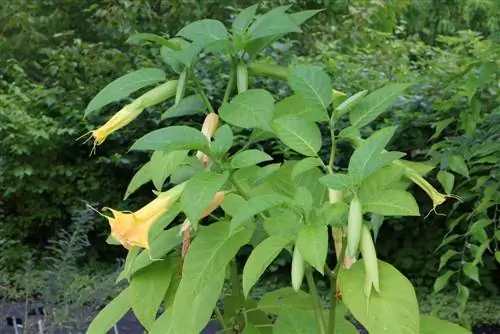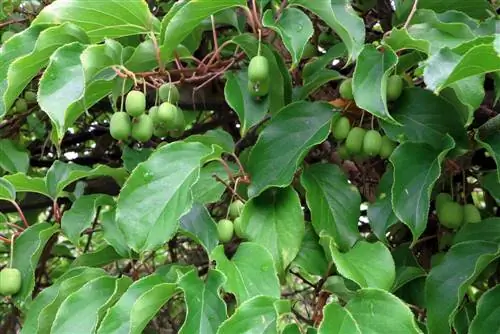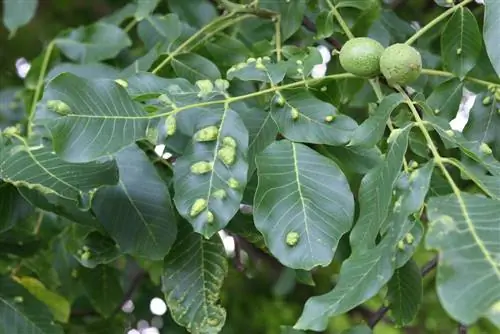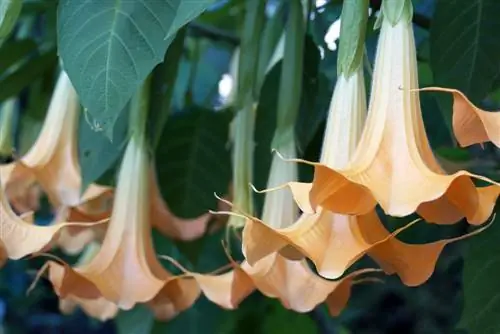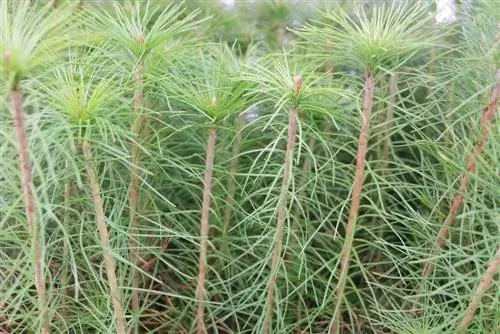- Author admin [email protected].
- Public 2023-12-17 03:39.
- Last modified 2025-06-01 06:48.
Imposing flowers and tall growth - angel trumpets have a fascinating and magnificent appearance. If it weren't for diseases that damage the plant and cause it to partially die. It is not always possible to determine exactly where the annoying pests and diseases come from. What is certain is that gardening help will be gratefully accepted in the event of Brugmansia.
Viral, fungal diseases and growths can occur with the angel's trumpet. Depending on the type or cause of the disease, the plant has a chance of survival. Some diseases are fatal for the plant.
Viral diseases
Unfortunately, the impressively flowering plant is a host plant for various viruses. There are many indications as to which virus has embedded itself in the plant. Control is difficult, but you can save the plant from year to year, so to speak.
Characteristics of general viral diseases are:
- Mosaic-like discoloration of the leaves, becoming larger
- Shoot tips become stunted or crippled
- Growth is inhibited until the plant dies
Countermeasure is a very good supply of water and fertilizer. The plant may not naturally have enough of it, but in this case give it enough. This allows her to recover “from therapy” and the symptoms disappear. However, when the symptoms disappear, the virus itself does not disappear. It stubbornly remains in the plant and the symptoms can appear again in the fall or next spring.
Tip:
Do not propagate plants that carry a virus. It can be passed on by cuttings. To avoid transmission, also remove the infected parts of the plant.
Stem brandy or stem brandy
This disease is caused by the tomato bronze virus. While with other diseases the plant has a chance of survival, stem blight leads to the death of the angel's trumpet. If the first signs become noticeable, the plant should be disposed of immediately as the disease is transmitted to other plants by insects.
License plates are:
- Brown to black spots and cracks on petioles, leaves and stems
- Plant wilts above the spots
Leaf spot disease
This disease looks more threatening than it is.
License plates are:
- Dark green spots with a light center
- Resemble sucking sites of insects
- Stains dry in the middle
- The “middle” then falls out
- Leaves dry up and fall off
With good care, the plant will recover from the disease.
Fungal diseases
Fungal diseases that occur include gray mold, root rot and stem rot. The latter two occur when plants are kept too moist. Especially with the angel's trumpet, it is important to ensure that the plant does not move to its winter quarters too wet, i.e. with a root ball that is too wet. To avoid all these fungal diseases, Brugmansia should not be watered too much in winter.
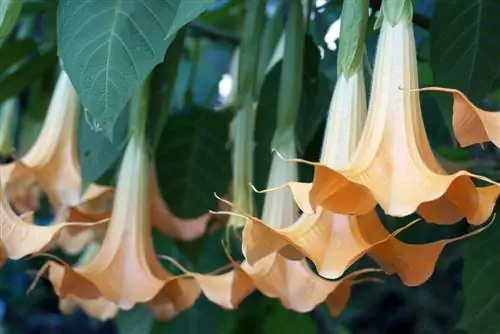
License plates are:
- Stunting growth
- Dull, gray-green leaves
- Leaves yellow and wilt
- Roots are brown and mushy
- Trunk foot is soft and squishy
In order to free the plant from the fungi, all damaged roots must be removed. Almost all leaves must also be removed so that Brugmansia can recover. Repot the plant and water it very little. An appropriate fungal agent also helps the plant. If stem areas have to be cut out, which only helps with older plants, Brugmansia should be treated with a wound closure containing a fungicide. However, if the fungus has penetrated too far, the angel's trumpet can no longer be saved.
Gray horse
Gray mold diseases usually occur when the plant's winter quarters are not well ventilated. The mold loves a warm, humid climate. The infestation often occurs when the plant enters its winter quarters too wet or is watered too much in winter.
License plates are:
- gray mold on leaves, stems or trunk
- Dead leaves in the pot and soil that is too moist promote mold formation
Gray mold is difficult to control. Countermeasures are:
- remove affected plant parts
- Use fungicide
If the infestation has progressed too far, the plant can no longer be saved and must be disposed of. To prevent the fungus from spreading, ensure there are large gaps between the plants.
Stem rot
Stem rot is another fungal disease. Phoma, the name of the fungus, is particularly feared in agricultural rapeseed cultivation because it can lead to high crop losses. If an infestation is detected, the affected parts of the plant must be removed immediately. The plant should also be separated from other plants. There are certain fungicides available from specialist agricultural retailers to combat it. Since the fungus can overwinter in the plant, you should also consider disposing of the plant.
License plates are:
- Black-brown, glassy spots on leaves
- Stains dry and become light
- Leaves curl up and eventually die
- Infestation can spread over the entire stem
- also attacks the roots
Growths
Growths can be compared to a cancerous disease. As a rule, this disease is rare. If there is rather unsightly wild growth around the trunk of the angel's trumpet, then it is a growth. But this superficial uncontrolled growth is not the problem. This is underground. Growths are crowding out the angel's trumpet's actual roots. The growths themselves die back in winter and cause rot. Ultimately, Brugmansia dies due to rot.
Growths should therefore be completely removed, including their roots. If the root ball of the angel's trumpet is severely injured, an appropriate wound closure agent will help

Tip:
In order to save the impressive plant, if the worst comes to the worst, it is better to dig deep into the root ball. Without help, she cannot survive.
Pests
The angel's trumpet not only delights the viewer, but also numerous pests. A pest infestation usually has little to do with incorrect care; the tiny “animals” often appear out of nowhere. Unfortunately, they don't disappear as quickly as they came. Rather the opposite is the case. They are stubborn and difficult to get rid of. It is important that control measures begin immediately in the event of an infestation.
Spider mites
Spider mites feel very comfortable in high temperatures and low humidity. They suck out the cell sap from the leaves. The leaf first looks finely mottled, then turns gray-brown and finally dries up. In addition, a very fine web adorns the leaves and their stems.
Combat:
- Over-the-counter sprays from specialist retailers
- Special granules that are incorporated into the soil
When combating with sprays, care must be taken to ensure that all parts of the plant are sprayed. Don't forget the undersides of the leaves and the substrate. In order to limit the spread of spider mites, also include the uninfested parts of the angel's trumpet in the measure. If granules are used, work them into the substrate by one to two centimeters as evenly as possible before pouring.
For prevention, spray Brugmansia regularly with lukewarm water during the outdoor season. Spider mites also like to attack angel trumpets in their winter quarters. Therefore, check the plant regularly for spider mites during overwintering and ventilate the winter quarters well.
Tip:
Spray Brugmansia and then immediately cover the plant and container in an airtight container. This means the chemical club can work better. After one or two days you can unpack the plant again.
Soft skin mites
With a size of 0.2 millimeters, tarsonomids are not visible to the naked eye. Brugmansia is at risk in warm, humid weather, usually from July to September. They attack the shoot tips of the angel's trumpet. Stunted and browning vegetation points are signs of infestation. Other characteristics include glassy, shiny leaves, leaf curls or small leaves. Soft skin mites are considered particularly difficult to combat.
Combat:
- Strong pruning
- Appropriate chemical control agent
Soft-skinned mites have a variety of host plants. Their eggs are also dispersed over long distances by the wind. In order to protect other plants, not just your own, from their infestation, combating the annoying pests must begin immediately.
Sheet bugs
Leaf bugs love soft, young leaves. They pierce the leaves and suck them out. The tiny puncture marks become larger as the leaves grow. They are surrounded by a dry edge. Since leaf bug saliva is toxic to Brugmansia, the leaves become twisted or crippled.
Exercise caution when inspecting for leaf bugs, starting at the tips of the shoots. At the slightest disturbance or danger, they drop or hide. In addition, leaf bugs are usually well camouflaged by their color and are only half a centimeter in size. So they are very difficult to spot.
Combat:
- Knock off and catch
- Neem preparations
You can only knock off and catch the annoying animals in the morning. They are in a kind of cold state and cannot escape so easily. Sprays made from neem oil are also not very popular with leaf bugs. But be careful: If they are driven away, they will quickly look for another plant in the neighborhood. That's why the leaf bugs really need to be removed, not just driven away.
Bigmouth Weevil
The beetle gets its name from its trunk-shaped head. It is shiny black and flightless. The beetles themselves and their larvae are harmful to the angel's trumpet. The beetle feeds on flowers and leaves at night and leaves behind cove-shaped feeding marks. During the day the beetles tend to sit on the ground or at the base of the plant. They can be removed by hand, with or without gloves.
The larvae of the black weevil are more difficult to control. The beetles lay countless eggs. Their larvae are headless and legless and are comparable in appearance to grubs. They eat the roots. Strictly speaking, this is why the larvae are much more dangerous to Brugmansia than the adult beetles. Although neither beetles nor larvae should attack the angel's trumpet. In addition to eating roots, the larvae also leave their droppings in the underground passages. This causes additional damage to the plant. Another danger posed by the larvae is that the eaten angel's trumpet becomes infected with harmful soil fungi. Eaten roots are injuries to the plant, and this is how the fungi can penetrate the angel's trumpet.
In order to combat it, it is important to know the life and reproduction of a black weevil. After pupation, the first beetles hatch in May. In principle, the voracious beetles can hatch until August. The beetles lay their eggs shortly after they hatch. That can be up to 800 eggs per insect! The first larvae hatch after two to three weeks. They immediately start eating the roots. After overwintering in the ground, they pupate in April and the reproductive process begins again.
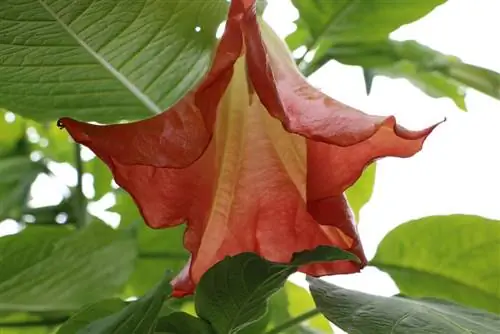
The best time to fight the larvae is April to May and August to September. In addition to threadworms, there are also special concentrates available from specialist retailers. As a precautionary measure in case of beetle infestation, repot Brugmansia and remove all larvae.
So that the beetle doesn't get a chance in the first place, its natural enemies should be encouraged. Since we cultivate angel trumpets as pot plants, blackbirds and titmice are their natural enemies. The beetle can also be driven away with garlic or neem tea. He doesn't like either taste. When considering expulsion strategies, please note that the beetle and its larvae also like many other plants: cyclamen, clematis, lilacs, fuchsias, ivy, heather, ferns, hydrangeas and much more.
So the Floriani principle should not be the first priority in combating it.
Tip:
It's best to collect the beetles in the dark with a flashlight. A trap made of flower pots filled with wood shavings under the plant is very effective. The light-shy beetles like to “hide” in them and can be removed during the day.
Snails
The leaves of Brugmansia taste very good to snails. Young snails in particular are very fond of the taste of the leaves. They like to crawl up the trunk to get to the delicious meal. The usual remedies from “crawling barriers” to snail pellets help against snail infestation.
Caterpillars
Caterpillars are an ambiguous pest. Of course, a caterpillar infestation can be contained. But butterflies are worth protecting. Nevertheless, caterpillars should be removed from the plant. They don't just eat the leaves bare. Flowers and buds are not spared from the voracious animals.
Aphids
If the plant is attacked by aphids, then the usual remedies against the annoying lice will help:
- Spraying with a soft soap solution
- Remove affected branches or shoots
- Remove aphids by hand (garden gloves), only if the infestation is weak
- If necessary: use chemical club
Attention:
If the angel's trumpet is or has to be cut down to its growing area, it will no longer develop flowers for the time being.
Conclusion
The angel's trumpet, which is easy to care for, attracts a whole range of pests. The plant is also not immune to diseases. But with a few tricks and tricks you can make the sought-after plant unattractive to pests. Unfortunately not for everyone. If the plant is too weak or too sick, it should be destroyed, even if the gardener's heart bleeds.

